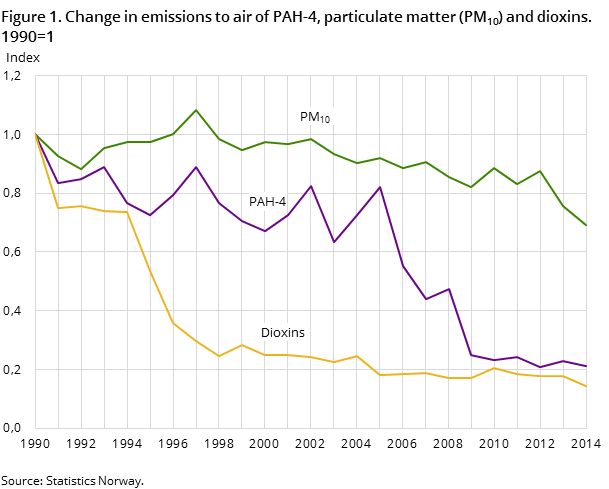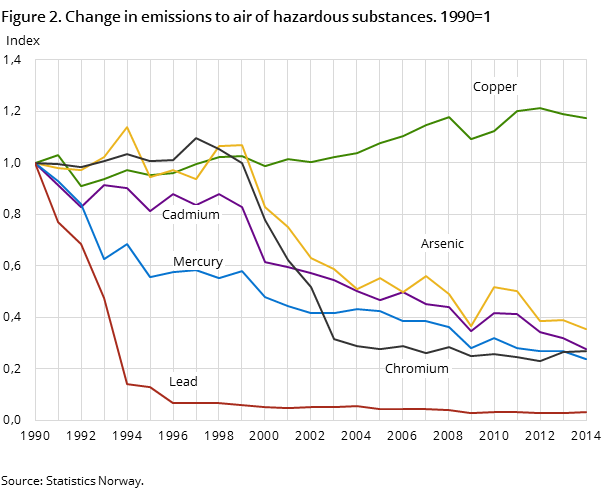Content
Published:
This is an archived release.
Reduced emissions of hazardous substances
The emissions to air of most hazardous substances were reduced from 2013 to 2014. Emissions of particulate matter decreased by 8 per cent.
| 2014 | Change in per cent | ||
|---|---|---|---|
| 2013 - 2014 | 1990 - 2014 | ||
| 1Does not include ocean transport and international air transport. | |||
| Lead (kg) | 5 650 | 2.1 | -97.0 |
| Cadmium (kg) | 413 | -13.6 | -72.5 |
| Mercury (kg) | 351 | -11.6 | -76.2 |
| Arsenic (kg) | 1 237 | -9.1 | -64.5 |
| Chromium (kg) | 3 038 | 1.4 | -73.0 |
| Copper (kg) | 28 182 | -1.3 | 17.5 |
| Particulates - PM10 (tonnes) | 35 231 | -8.2 | -30.7 |
| PAH-4 (kg) | 7 728 | -7.6 | -78.8 |
| Dioxins (g) | 17 | -19.1 | -85.5 |


From 2013 to 2014 there was a decrease in emissions to air of cadmium, mercury, arsenic, copper, PAHs (polycyclic aromatic hydrocarbons) and dioxins, while emissions of lead and chromium increased somewhat. Emissions of particulate matter were also lower in 2014 than in 2013.
Decrease in most emissions since 1990
Emissions of most hazardous substances have been reduced considerably since 1990. The cause of the decrease since 1990 is primarily reduced emissions within manufacturing and mining. Cleaning measures, changes in production procedures and lower activity in some industries have all resulted in reduced emissions. Norway has a national target to reduce emissions compared with the emission levels in 1995. Internationally, we have an obligation to reduce emissions of selected hazardous substances compared with 1990.
Wood-burning most important source for particulate matter
Emissions of particulate matter (PM10) amounted to 35 200 tonnes in 2014. This is 8 per cent less than the preceding year. Almost half of the emissions of particulate matter (PM10) in 2014 came from wood-burning. The wood consumption decreased by 14 per cent from 2013 to 2014, which may be connected with the fact that 2014 was a record mild year. At the same time, the calculated emissions of particulate matter from this source decreased by 14 per cent. Emissions from manufacturing and mining amounted to 8 400 tonnes, or 24 per cent of the emissions of particulate matter in 2014. Coastal navigation and fishing and oil and gas extraction were each responsible for 5 per cent of the emissions.
Reduced emissions of most hazardous substances
Emissions of mercury amounted to 0.4 tonnes in 2014, which is a 12 per cent decrease from 2013. Manufacturing industries and cremations were the most important emission sources, with 27 and 22 per cent of the total respectively. Mercury emissions were 76 per cent lower in 2014 than in 1990, mainly due to a 93 per cent reduction from the metal-working industry during the period.
In 2014, 17 grams of dioxins were emitted to air; 19 per cent less than the preceding year. Wood-burning in households is now the most important source for emissions to air of dioxins in Norway, and was responsible for 31 per cent of the emissions in 2014. Since 1990, the dioxin emissions have been reduced by 86 per cent, mainly due to lower emissions from mines and metal-working industry, which were the most important sources at that time.
Emissions to air of copper amounted to 28 tonnes in 2014, which is a 1 per cent decrease from 2013. Emissions from brake blocks are the dominant source for emissions to air of copper, and these emissions amounted to 53 per cent of the total in 2014. Emissions from this source have grown by more than 50 per cent from 1990, and this has caused that copper emissions are the only emissions of hazardous substances that are higher in 2014 than in 1990. In 2014, total copper emissions had grown by 18 per cent from 1990.
In 2014, 1.2 tonnes of arsenic were emitted to air, which is a 9 per cent decrease from 2013. In recent years, the variation in arsenic emissions has been due to varying arsenic content in raw materials and reducing agents used in metal production. Emissions from manufacturing and mining accounted for more than 50 per cent of the total arsenic emissions to air in 2014. Emissions from the metal-working industry, which constituted half of the arsenic emissions in 1990, were reduced by 70 per cent in the period up to 2014.
Emissions to air of cadmium totalled 0.4 tonnes in 2014. Cadmium emissions have decreased by 14 per cent since 2013 .Wood-burning in private households is now the most important source for emissions of cadmium to air in Norway, and contributed with 22 per cent of the total emissions in 2014. The emissions of cadmium were 73 per cent lower in 2014 than in 1990, largely due to a 93 per cent reduction in emissions from the metal-working industry.
Increase in emissions of lead and chromium
In 2014, 5.7 tonnes of lead were emitted to air, which was a 2 per cent increase from 2013. Emissions from brake blocks and process emissions from the metal-working industry are now the dominant sources for emissions to air of lead. Since 1990, the lead emissions have been reduced by 97 per cent, mainly due to the phasing out of leaded petrol in the early 1990s.
Emissions to air of chromium amounted to 3.0 tonnes in 2014. This is 1 per cent more than in 2013. Combustion in the chemical industry is now the dominant source of chromium emissions to air in Norway. In 2014, these emissions amounted to 31 per cent of the total emissions. In 1990, the metal-working industry was the most important emission source for chromium, with 75 per cent of the total, but in 2014 these emissions were reduced by 96 per cent.
Lower emissions of PAH-4
In 2014, 7.7 tonnes of PAH-4 were emitted to air, which is 8 per cent less than in 2013. Process emissions from aluminium production are the major source for PAH-4 emissions, and these emissions constituted 58 per cent of the total in 2014. PAH-4 emissions from aluminium production have been reduced by 85 per cent since 1990. Wood-burning is the second most important source, and contributed with 16 per cent of the emissions in 2014. Road traffic made up 19 per cent of the emissions in 2014. This includes wear on roads, tyres and brakes.
International agreementsOpen and readClose
Through various international agreements, Norway has committed to reducing its emissions to air of certain hazardous substances from the 1990 level. Different protocols under the Convention on Long-Range Transboundary Air Pollution (CLRTAP) set out the targets for emissions with regional effects. One of these protocols, the Aarhus Protocol, stipulates the commitments for the reduction of PAHs, dioxins, lead, cadmium and mercury. There are no commitments for copper, chromium or arsenic, but there are requirements for reporting emissions.
Differences between emissions to air and local air quality Open and readClose
The figures calculated in these statistics are emissions to air, i.e. the amount of particulate matter coming from chimneys, exhaust pipes etc. This is not to be confused with local air quality or concentrations, which is the amount of substance that is actually inhaled by humans. In concentration calculations, the fact that humans are more exposed to some emission sources than others is taken into account. For instance, emissions from wood-burning are often emitted from chimneys, and do not affect local air quality to the same extent as exhaust emissions. For this reason, one tonne of particulate matter from wood-burning is less significant to concentrations at ground level than one tonne from exhaust.
The health risks associated with local air pollution depend on how high the concentration of the polluting substance is, and on length of exposure.
The statistics is published with Emissions to air.
Contact
-
Statistics Norway's Information Centre
E-mail: informasjon@ssb.no
tel.: (+47) 21 09 46 42
